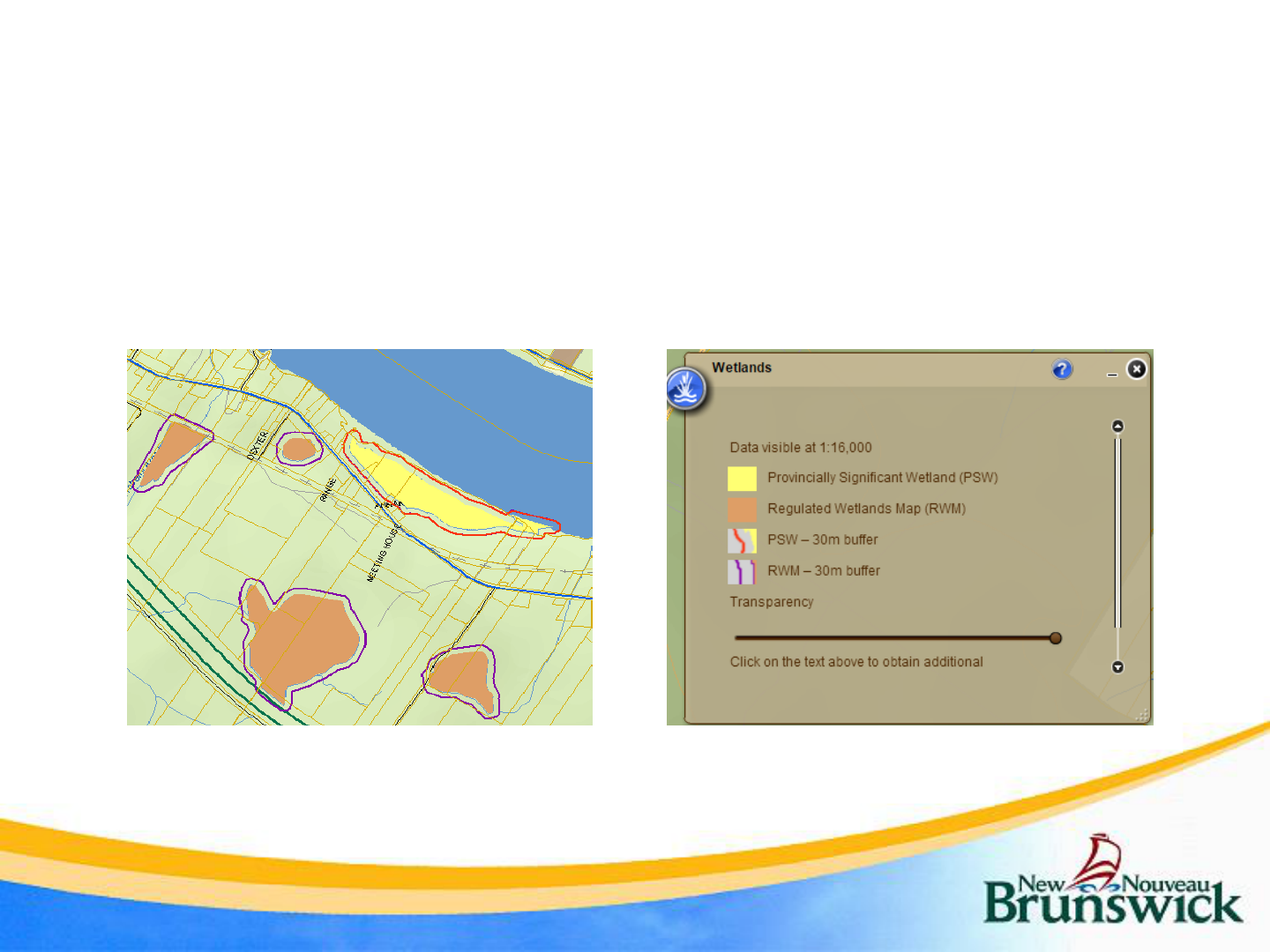
Department of Environment
and Local Government
WAWA Reference Map
Joanie Bertin – Wetland Biologist


FLOOD 2018/19

On January 1st, 2020 an
updated online Watercourse
and Wetland Alteration
(WAWA) Reference Map
was released.
WAWA Reference Map

The map will be updated on an annual basis and be comprised of
the most recent GIS information available. The new map replaces
the previous wetland map on GeoNB and is to be used as a
reference tool only.
WAWA Reference Map

The wetland mapping is made of most recent layers of wetlands, peatlands,
wet/poorly drained forests. The data is interpreted by aerial photo using LiDAR-
based indicators to identify potential wetlands. The map also includes delineations
and field verification.
WAWA Reference Map

Watercourse and Wetland Identification
2. Check the Definitions
Bed, banks and sides of
any incised channel
greater than 0.5 metres in
width that displays a rock
or soil bed; water/flow
does not have to be
continuous and may be
absent during any time of
year; or a natural or man-
made basin.
Water table at, near, or
above the land’s surface,
or which is saturated, for a
long enough period to
promote wetland or
aquatic processes as
indicated, by hydric
soils, hydrophytic
vegetation
Watercourse
Wetland

3. Walk the Property to Check for Unmapped Wetland Features
• Areas where water is likely to collect:
low spots or depressions, near a stream
or river that floods, in heavy/clay soils,
highly organic soils, smells like rotten
eggs.
• Signs of flooding near the surface: the
water table is close to the surface water
seeps when a hole is dug, no shrubs or
trees are present.
• Common wetland plants: peat moss,
sedges, cattails, ferns, black spruce,
cedar, or alders.
Watercourse and Wetland Identification

Non-Forested Wetlands in New
Brunswick
Bog Fen
Coastal Marsh
Aquatic Bed
Freshwater Marsh

Forested and Shrub Wetlands in
New Brunswick
Forested Wetland
Floodplain
Forested Bog
Alder Thicket
Shrub Swamp

4. Wetland presence/absence and/or delineation
Watercourse and Wetland Identification
Residential subdivision development, a commercial property or an industrial
site - Contact a wetland professional/consultant to assess their property.
Residential property - Contact the regional office, and a Wetland Biologist will
provide guidance on next steps and if required will identify wetland boundary onsite
during growing season.
Under certain circumstances a presence/absence survey or desktop identification of
wetland boundaries may suffice.

Two types of wetlands:
• Provincially Significant Wetlands (yellow), and
• Wetlands (orange)
GeoNB Map Viewer

Provincially Significant Wetlands
Wetlands of provincial, national or international significance for one or more of
the following reasons:
• Coastal marshes
• Home to one or more endangered species
• Social or cultural value
• Significant hydrological value, especially for flood control
• National wildlife reserve or protected natural areas
Alterations are very limited in or within 30 meters of a provincially significant
wetland.

Wetlands: permitting
• All wetlands ≥1 ha in size
• Any wetland <1 ha in size and not
contiguous to a watercourse is not a
regulated feature and does not
require a WAWA permit.
• Alterations in or within 30 metres of
wetlands ≥ 2 ha in size or having the
potential to affect these wetlands may
trigger an EIA.

Wetlands
The review of a project is based on a three-step approach aimed at reducing
the impacts of the project :
1) avoidance during the planning phase
2) mitigation techniques during the construction phase
3) compensation for permanent residual impacts
Any alteration that results in permanent loss of wetland habitat requires
compensation at a 2: 1 ratio.

Watercourse: when is a permit required?
• All mapped watercourses
depicted on Service New
Brunswick’s GeoNB Map
Viewer require a permit.
• All unmapped watercourses
that meet the working
definition of a watercourse
requires a permit (defined
channel; >0.5 metres; rock
or soil bed).

Permitting
• All WAWA permit applications are processed through an online
application program.
• Permitting is done through a “single window” approach.
• Project considered high risk (i.e. have the potential of resulting in
serious harm to fish) are also reviewed by our advisory agents (DFO
and DNR).

Permit Application Requirements
• Full, comprehensive description of the proposed project, with
dimensions and distances in relation to the project and the
regulated feature(s).
• Drawings/plans may be required depending on the type of
project.
• A consent letter is required if the applicant is not the legal
owner of the property.
• Photographs of the site.

Provisional Permits
• For alterations that are considered low risk/ low impact to the
environment
• Turnaround time: 10 working days
• Cost: $10 per application
• Does not apply in:
o Wellfield Protected Areas
o Watershed Protected Areas
o Provincially Significant Wetland Areas

• For more complex projects (alterations not covered under a
Provisional Permit).
• Application fee:
o $25 (single alteration)
o $20 per alteration to a maximum of $200 (multiple permit)
• Turnaround time is typically between 3-4 weeks. May be
longer for projects requiring advisory input.
Standard Permits

Source and Surface Water Management
Branch
Telephone: (506) 457-4850
Email: [email protected]a
Online application

